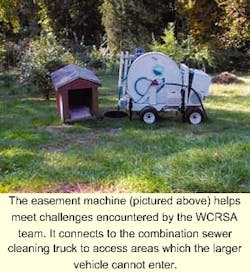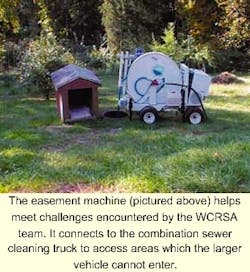In-House Inspection, Cleaning Program Saves Regional Sewer Authority Money
The Western Carolina Regional Sewer Authority (WCRSA) has seen many changes since its inception in 1925. The Authority is a governmental, non-profit agency that is governed by nine board members who are appointed by the governor and currently employs a staff of 190.
The Sewer Authority serves five counties that include Greenville, portions of Spartanburg, Anderson, Pickens and Laurens, which includes 12 sewer subdistricts that handle the collector lines. WCRSA owns and operates 12 wastewater treatment plants, 59 pump stations, provides over 350 miles of trunk sewer line and treats over 40 million gallons of wastewater each day.
The area has been growing rapidly, thanks in part to the influx of major corporations such as Amoco, Hitachi, Kemet, Mitsubishi, Columbia Farms and Michelin North America. The authority has seen an increase of 2,000 new accounts per year over the last several years.
With all of these changes, the Board of Commissioners considered a shift in how the Collection Department would be run. The department is responsible for the cleaning, TV inspection and trunk line maintenance and repair, force main and air relief valve maintenance, right-of-way maintenance, pump station and treatment plant cleaning, SSES studies, and system mapping.
The majority of TV inspection and cleaning was performed by outside contractors with the in-house crew doing spot cleaning and addressing problem areas as needed. The board requested an extensive study of the yearly costs and the amount of line cleaned by contractors. After comparing the numbers to the cost of hiring a crew and purchasing the equipment, the authority found that it would be less expensive to bring this function in-house.
"With the contractors we were averaging 25-35 miles of line per year at an average cost of $700,000. In the first year, considering the purchase of the equipment, salaries, benefits, etc., you'd expect to be in the red, but by the second year, if the program was successful, the department would see an estimated savings of $300,000 to $400,000 per year by bringing the work in-house," said Sammie Barnett, TV & Cleaning Supervisor for the authority.
At the same time the transition from outside contractors to in-house TV inspection and cleaning services was taking place, the authority had Sanitary Sewer Overflow and stringent EPA regulations coming forth and was developing a voluntary Management Operation and Maintenance (MOM) audit report on its sewer systems. The report provided valuable information on how the authority could make the system perform at its peak efficiency.
Authority officials also reviewed their field forms and physical inspection books. This process and the MOM report helped guide the department into a proactive approach to maintenance. By assuming a proactive mode vs. reactive as the area expanded and was upgraded, officials believed they would be able to keep up with increased capacity requirements.
The MOM report outlined a cleaning and TV inspection program to be conducted over a 10-year period. The report broke down the system into plants and basins, with a total of 350 miles of trunk line. A goal was set to complete 35 miles of trunk line per year, so that upon the end of the term, 100 percent of the system would have been inspected and cleaned. The process would then begin again.
"Our main goal with this proactive approach was to inspect and clean the collection system, to identify defects and develop rehab strategies," Barnett said. "In order to treat wastewater, you have to get it to the plant. With this process, you are going into every line, inspecting for structural integrity, capacity problems, leaks and obstructions.
"For instance, you may be inspecting a manhole or a line you know was done in 1996, but since then, a contractor tied in a service line and failed to grout around the connection and now groundwater is up and water is leaking around the service tap," he said. "With a scheduled program of cleaning and inspection, our crew can see the problems before they become critical and send word to the proper crew or department so the necessary rehab repairs can be made."
The authority found it had some unusual needs. Since it is responsible for trunk sewers, most of its lines range in size from 15 inches to 72 inches in diameter.
"The equipment had to fit the system needs," Barnett said. "What makes us unique is that unlike most municipalities, 95 percent of our sewer lines are off-road and only 5 percent are in the street. This creates big challenges with easements and access."
Authority personnel went to shows, researched most of the vendors, talked with other municipalities and attended demonstrations. In the end, they purchased some typical and not-so-typical equipment.
The authority purchased $700,000 worth of equipment that included a Vac-Con combination sewer-cleaning unit, a set of bucket machines, an easement machine from Sreco, Sewer Scooters, a Kawasaki Mule ATV, a small dump truck, a TV inspection camera system and vehicle from Pearpoint, Flexidatatrademark pipe survey reporting software, and a 4x4 crew-cab truck outfitted with an expansive variety of tools and safety equipment.
Some of the equipment wasn't stock order; for instance, the authority's vacuum unit has a 16-yard debris box with an 80 gpm, 3000 psi pump, extended boom and extra tubes for things other than sewer lines like treatment plant cleaning projects.
"We also have a pump station crew of six (three electricians, three mechanics) that operate and maintain the pump stations, the TV & Clean crew performs wet well cleaning, debris removal and various types of treatment plant projects. If it's out there, at one time or another we've cleaned it," Barnett said.
The authority's TV inspection camera system and van had to meet some tough criteria because of the nature of the region.
"We had to have something that would go from a 6 inch to 96 inch pipe with no problem and the tractor had to be able to withstand extremely heavy flow and debris," said Barnett.
The van is 4-wheel drive with a winch mounted on the front and is equipped with tow hooks.
"We don't shy away from dirt and mud, it's just the nature of our terrain and the system," Barnett said.
The Kawasaki ATV is an invaluable tool, since much of the work is off-road. In addition to the mainline TV system inspection van, the authority also purchased a Pearpoint portable TV system with a separate cable reel and controller that works with the camera and both tractors from the van. The portable system is loaded into the bed of the ATV along with the necessary tools and accessories and the crew can access lines in remote areas of yards, pastures and woods.
The ATV and portable system have gone a long way in building goodwill in the community, Barnett said.
"One of our biggest problems is that people don't understand that when they purchase a home and add fencing and landscaping it can often pose access problems for our crews," he said. "By having the portable system that we put on the ATV, and an easement machine, we can enter yards and continue our project without interruption or undue disruption to the homeowner."
As part of its proactive program, when the authority receives a report of a sewer system overflow, a crew is dispatched to unstop and clean the line, then the TV crew sends their camera in the line to inspect each overflow site for the exact cause of the problem.
In one case they encountered steel pins used for marking property lines driven into the top of an 8 inch clay pipe. The pins had been driven flush to the ground and were not visible during an above ground inspection. Once the pins were discovered by the camera crew, the line maintenance crews repaired the line.
"We haven't had a problem in that area since, " Barnett said.
The Collection Department is proud of its accomplishments. The department will be expanding as the area grows in accordance with the MOM report. In fact, because of the steady growth, the authority is planning a $100 million upgrade of its treatment facilities during the next three years.
The authority is into the second year of the program and at the close of year one, crews had cleaned and inspected 37 miles of line (two miles over the goal). They have cleaned 85 pump station wet wells (There are 59 in the Authority and some were cleaned twice), and completed more than 25 other cleaning projects at various wastewater treatment plant sites such as digesters, influent wet wells, clarifiers, and grit chambers.
Two other major accomplishments were the 100 percent completion of the SSES for every line segment in the system that was begun in 1985 and finished in October 1999, and GPS readings on some 17,000 manholes, pump stations, and treatment facilities. They have worked hard and diligently, and the proactive approach has proven successful.
Historical problem areas with overflows have been cleaned, inspected and necessary repairs made and no repeats of the problems have occurred in over two years since the program's implementation.
"It's like oil changes for your car, " Barnett said, "if you take care of the system it will save you money in the long run, it will run better, be more energy efficient and reduce environmental risks."
For other municipalities that are considering a change or looking for ideas to make their systems better and more efficient, Barnett offered this, "Really study your system, know it inside and out, map your terrain and detail your system's special needs. Don't buy equipment because it is the most expensive or least expensive or go by what others say. Buy it based on what your system needs are.



